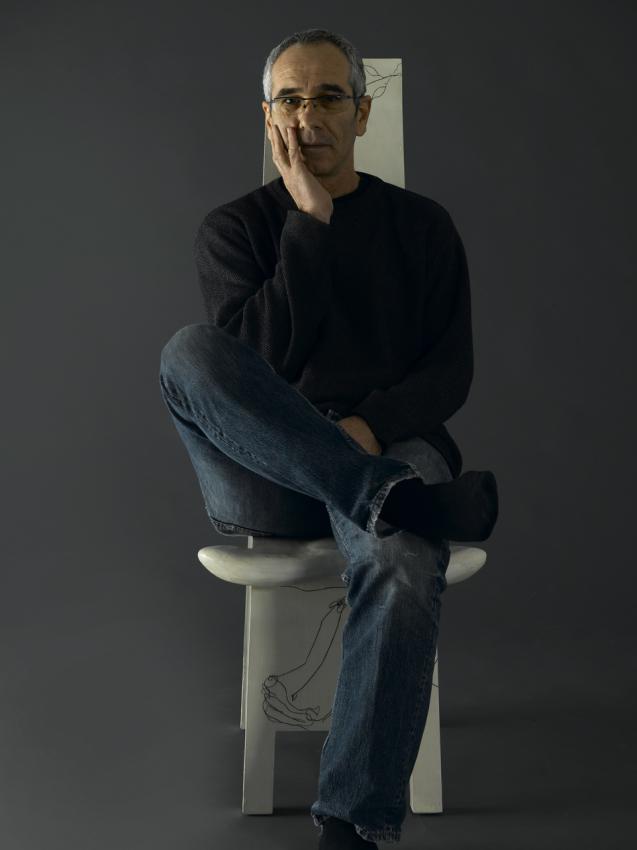Prof. Chanan de Lange is former Head of the Department of Industrial Design at the Bezalel Academy of Arts and Design in Jerusalem and, together with architect Tal de Lange, heads the prominent Studio de Lange that has been involved in a large variety of industrial and private projects. Prof. de Lange was appointed by Yad Vashem to coordinate the layout of the new Jewish exhibition at the Auschwitz-Birkenau State Museum. In a special interview preceding the opening of the new exhibition, Prof. De Lange described the complex process of designing the space together with the Studio's team and Project Manager Shirley Marco, as well as the idea that lay behind its unique "Book of Names," which they also created.
What were your initial thoughts regarding the exhibition's design concept?
After studying the proposals for the new exhibition, we came to the conclusion that its design within Block 27 of the State Museum must be suffused with two primary features: simplicity and the senses. This derives from the paramount difficulty of conveying – in general as human beings and specifically as Jews – what transpired during those painful years. As renowned Holocaust survivor Georges Perec said: "A gap will yawn, achingly, day by day, it will turn into a colossal pit, an abyss without foundation, a gradual invasion of words by margins, blank and insignificant, so that all of us, to a man, will find nothing to say." Our challenge was to create an exhibition that expresses such a horrifying historical event in an unpretentious, clear and accurate manner to the visitors – most of whom are young, non-Jewish, European citizens.
The design process comprised hundreds of hours of discussion and contemplation, occurring during three years of consultation with the project's steering committee, as well as with experts from the fields of architecture, art, communications, typography and cinema. We also worked with specialist engineers, who assisted with the building and preservation work in the Block, voice and sound technicians, acoustical experts and more.
The results of this collaborative effort are striking spaces with clean, minimalist lines that impart the historical facts clearly and directly. Each space within the exhibition presents its specific content differently, but all of them invoke the basic human senses so that the visit becomes experiential as well as educational. Our aim was to allow visitors to absorb and internalize what they encounter over a relatively brief period of time, and depart with renewed insights regarding their own contemporary existence.
How did you utilize the original structure?
A red-brick building inside the Auschwitz-Birkenau Museum complex, comprising 1,000 square meters spread over two stories, Block 27 is one of dozens of other similar structures at Auschwitz now dedicated by the Museum to relating the wartime experiences of different national groups at the concentration and extermination camp. For us, as designers of the Jewish exhibition, it was important to maintain the original spaces inside the Block as far as possible, including keeping the windows uncovered in order to underscore the connection between the exhibition and its authentic, historic surroundings. Thus, also, in contrast to the other Blocks, the visitors' route through the exhibition purposely concludes at its rear exit, which faces the barbed wire surrounding the camp.
Can you describe the new Exhibition's "Book of Names"? How did you devise its unique design?
One of Yad Vashem's central missions is to collect the name of each and every individual Shoah victim. This vital project, ongoing for six decades, has resulted in the recording of 4.2 million names so far – a remarkable accomplishment, but one that is not simple to impart experientially.
Our goal was to create an everlasting, permanent memorial to these murdered Jewish men, women and children – one that would encompass both their inconceivable numbers as well as their individual identities. I believe the Exhibition's "Book of Names" does precisely that. Every name, birth date, home town and place of death is clearly printed on the meter-high pages, illuminated by a gentle strip of light that lies between each page. Thus one can search for, pinpoint and even touch the data of any individual victim, and commemorate him or her in a private, personal way. However, the monumental size of the exhibit – 58 volumes of 140 pages each, 500 names per page, measuring 2m high and 14m in circumference – also attests to the collective, immeasurable loss to the entire Jewish people, and to humanity. The blank pages of the book's final volume, await the names still to be redeemed, recorded and memorialized in perpetuity by Yad Vashem.
All of the names in the Book of Names are taken from Pages of Testimony in Yad Vashem's Hall of Names, as well as from assorted lists compiled during the Shoah. Pages of Testimony are special one-page forms designed to restore the personal identity and brief life stories of each one of the six million Jews murdered by the Nazis and their accomplices. Submitted by survivors, remaining family members or friends and acquaintances in commemoration of Jews who were murdered in the Holocaust, Pages of Testimony document the names, biographical details and, when available, photographs, of each individual victim. All the names can be accessed/searched for online on the Central Database of Shoah Victims' Names. More about Pages of Testimony and the Hall of Names.







